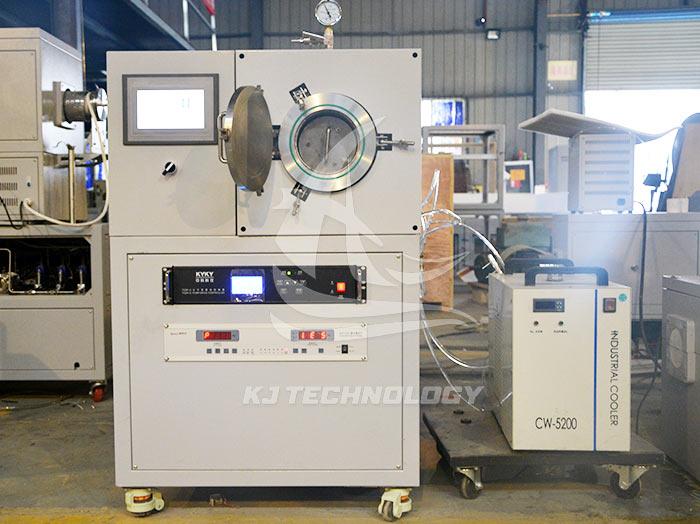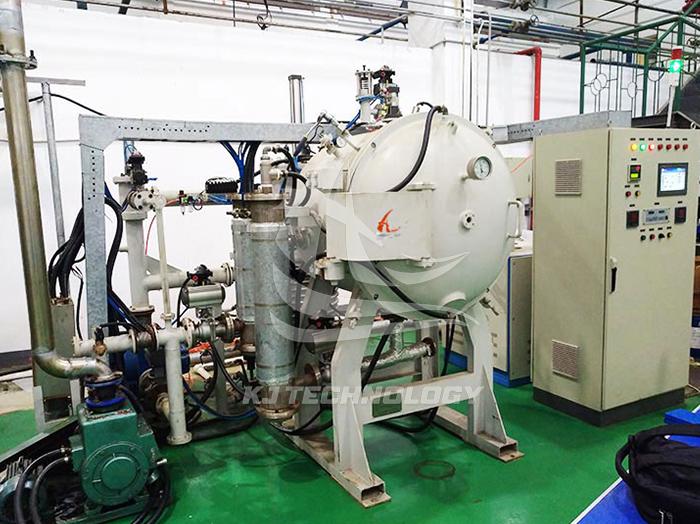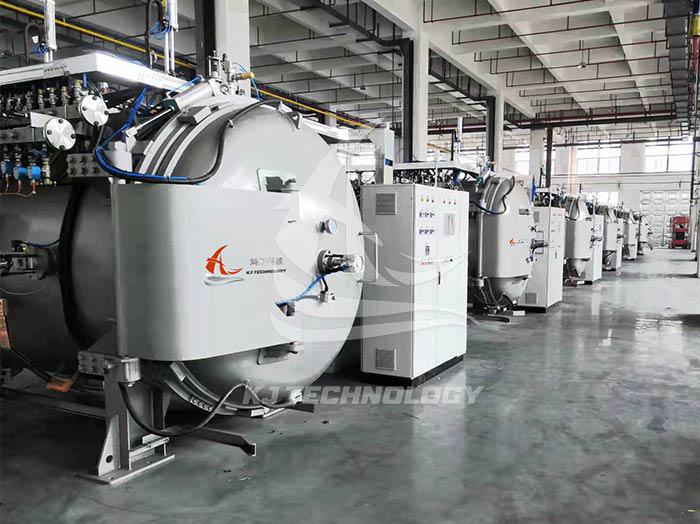What are the characteristics of a vacuum hot press furnace?
 07-07-2025 Author: KJ technology
07-07-2025 Author: KJ technology
A vacuum hot press furnace is a precision equipment that integrates vacuum environment, high-temperature heating, and mechanical pressurization. Its characteristics can be summarized as follows:
1. Core functional features
Vacuum environment ensures the purity of materials
By using a vacuum system (oil diffusion pump+Roots pump+mechanical pump), the pressure inside the furnace is pumped to ≤ 10 ⁻ Pa, eliminating reactive gases such as oxygen and nitrogen, and preventing materials from oxidizing, decarbonizing, or nitriding at high temperatures.
Typical scenario: When sintering titanium alloys, the vacuum environment can control the oxygen content to ≤ 0.01%, significantly improving the fatigue life of the material.
High temperature heating and uniform temperature control
Using graphite, molybdenum wire and other heating elements, the temperature range reaches 800-2200 ℃, the temperature control accuracy is ± 1 ℃, and the uniformity is ± 5 ℃.
Technical advantages: Different temperature control components are used in the low-temperature and high-temperature sections to achieve automatic switching and avoid temperature fluctuations affecting material properties.
Mechanical pressurization promotes densification
The hydraulic system applies an adjustable pressure of 10-500 tons through the pressure head, with a pressure adjustment accuracy of ± 100 N, achieving the functions of stabilizing and maintaining pressure.
Application effect: When sintering silicon carbide ceramics, pressure promotes particle rearrangement and diffusion bonding, resulting in a density of up to 99.8% and a bending strength of ≥ 800 MPa.
2. Structural and material advantages
Design of double-layer water-cooled furnace body
The inner layer is made of 304 stainless steel, the outer layer is made of carbon steel, and the middle is cooled by circulating water to ensure that the furnace wall temperature is ≤ 60 ℃, prolong equipment life, and reduce environmental impact.
Unique design: The furnace cover can be manually fully opened for easy loading and maintenance; The upper and lower flanges of the furnace body are welded together as a whole to avoid air leakage.
High strength frame support structure
The double column structure using profile welding ensures the stability of the equipment under high pressure and prevents deformation or shaking.
Typical configuration: The center hole of the press bracket is precision machined by a machining center, and the displacement deviation of the press head is ≤ 0.02 mm to ensure the accuracy of the pressure application.
Advanced insulation and thermal insulation materials
The furnace insulation screen is composed of carbon felt, graphite cylinder, and stainless steel plate, with low thermal conductivity. It can effectively isolate heat even at high temperatures of 2000 ℃, saving energy consumption.
3. Intelligence and automation control
Computer System Integrated Control
Using PLC touch screen or PID function instrument, achieve one key start and full automation operation of heating, pressurization, vacuuming and other processes.
Data management: supports real-time monitoring and storage of sintering temperature, vacuum degree, pressure and other parameters, facilitating process optimization and quality traceability.
Multiple security protection mechanisms
Equipped with functions such as over temperature sound and light alarm, leakage protection, overvoltage protection, water cut-off alarm, etc., to ensure the safe and reliable operation of the equipment.
Emergency design: The vacuum system is equipped with an electromagnetic pressure differential valve to prevent mechanical pump oil from flowing back in case of sudden power outage and avoid equipment damage.
Flexible atmosphere control options
In addition to vacuum environment, inert or reducing gases such as nitrogen and argon can also be filled to meet the sintering needs of different materials.
Inflating system: equipped with electromagnetic vent valve and pressure sensor, automatically exhausts when the furnace pressure exceeds the safe value, ensuring safe operation.
4. Process adaptability advantage
Multi material compatibility
Suitable for sintering and hot pressing of various materials such as hard alloys, functional ceramics, powder metallurgy, metal matrix composites, nanomaterials, etc.
Typical case:
Sintered transparent ceramics (such as YAG) with a transmittance of ≥ 85%;
Prepare silicon nitride ceramic bearing balls with a roundness error of ≤ 0.5 μ m;
Hot pressed silicon carbide reflector with a surface accuracy of λ/20.
Inhibit grain coarsening
The temperature of vacuum hot pressing sintering is 200-400 ℃ lower than that of atmospheric pressure sintering, effectively preventing the growth of nano material grains and improving the stability of product performance.
Data support: The sintering driving force of nano powder products is dozens or even hundreds of times higher than that of ordinary products, and vacuum hot pressing can achieve fine crystal structure.
Ability to form complex shapes
Pressure promotes the thermoplastic flow of powder materials, which can be used to prepare complex shaped and irregular parts such as thin-walled tubes and spherical column products.
Technological breakthrough: The hot pressing method overcomes the disadvantages of cold pressing and sintering deformation, and can obtain non bending long pieces and precisely sized hollow products.
5. Efficient and energy-saving design
One to two double furnace structure (some models)
The one to two vacuum hot pressing furnace of Haoyue Technology adopts a dual press and dual furnace body design, sharing a set of vacuum system and control system, with small footprint, high stability, low cost, and doubled efficiency.
Application scenario: It can simultaneously sinter two different materials (such as hard alloy+ceramic) to meet diverse production needs.
Rapid heating and energy-saving design
Optimization of heating element layout, combined with advanced insulation materials, to achieve rapid heating (such as raising from room temperature to 1600 ℃ in only 1-2 hours) and shorten production cycle.
Energy consumption comparison: Vacuum hot pressing sintering saves 20% -30% energy and reduces operating costs compared to traditional atmospheric pressure sintering.








